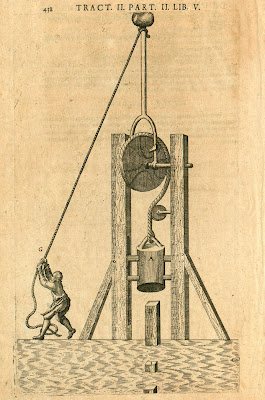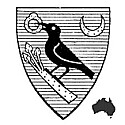






















These are further example illustrations from mystic rosicrucian Robert Fludd's 'De Naturae Simia'. This book forms part of the encyclopaedic series issued over 9 years to 1626 called 'Utriusque Cosmi Maioris Scilicet et Minores Metaphysica, Physica Atque Technica Historia'. Although it doesn't appear to be stated anywhere, I had a distinct feeling that the University of Utah website contains more than just the 'De Naturae Simia' illustrations.
The images above and in the previous post on Flood constitute a very small sampling of the veritable multitude of illustrations from Merian/de Bry seen throughout Fludd's work. Again, you can find the page/section locations for each image by checking the alt tags.
As with so many publications from this period it's difficult to speculate about the extent to which the contents may have been copied or modified from other sources. Certainly the machines and the fortification and perspective images above bear similarities to earlier works (think Dürer and Ramelli) but these subjects were at the forefront of technological theorizing during the renaissance so a certain repetition of core design principles (the waterwheel for instance) could be expected. There is also the influence and experience (and reused engraving plates!) that the printshop and illustrators brought to the projects.
Fludd is credited with one theoretical concept (not shown above) that, to an extent supports the notion that he contributed his own ideas, rather than merely extracting material from older sources. He described a perpetual motion system in which a water source would turn a wheel which in turn would be able to both grind grain and also drive an Archimedes screw pump to return the water to its origin, able to fall again and continue to power the process. It's completely fanciful of course but this was an era when there was no knowledge of the laws of thermodynamics and speculative entrepreneurs even attempted to obtain patents on aspects of Fludd's design up to the 19th century.
- Perpetual Motion.
- Professor Hibbert's Perpetual Motion Pages.
- Perpetual Futility - A short history of the search for perpetual motion.
- Will someone build a perpetual motion machine?
- The Museum of unworkable devices.
- HP-Gramatke: Perpetuum Mobile
- The complete scanned 'Utrisque cosmici' by Robert Fludd at the Max Planck Society ECHO Project.



















8 comments :
That's very nice Yaronimus. Thanks for sharing!
Hello,
for further reading on perpetual motion, also my site hp-gramatke.net could be of interest. A very good scan of Fludd's "Utrisque cosmici" can be found at the MPIWG under http://nausikaa2.mpiwg-berlin.mpg.de/cgi-bin/toc/toc.x.cgi?dir=USXW8SDP&step=thumb
regards, HPG
Great prints! I had no idea that Fludd had any interest in machines at all. These designs seem to cover the entire resume of a seventeenth century engineer: civil, military, and surveyor. His water-wheel designs seem largely derivative ofSolomon de Caus (pl. 11 of Illustrations de La raison des forces--available at Gallica). I think that Fludd's barel organ designs are also de Caus originals. The turbine-driven archimedes screw was described well before Fludd's design. Jean Errard de Bar-Le-Duc, for example, presented something remarkably similar in his machine book of 1584. Fludd's fortification designs are also quite trippy. I'm not a fortification expert but I think that his pentagonal fortress demonstrates a strong Italian influence as evidenced by the rounded corners (or "orillons") of the bastions. This approach seems a bit old fashioned in Fludd's day since straight flanks had come into fashion during the early days of the 80-years war between the Spanish and the Dutch. His cannon miscellany also has a strong martial air that reminds me of that sketchbook you posted last year. Fludd's movable battery is also of some interest. Diverse authors like Ramelli and Valturio had presented similar designs. And there is some evidence they were actually used. Duffy, for example, describes the bloody Spanish siege of Ostende (1603) where Spinola deployed "the last of Targone's inventions, a mobile drawbridge mounted on four ten-foot wheels. A single cannon shot shattered one of the wheels and immobilised the machine for good." Finally, Fludd seems to devote a good deal of effort on the back-staff, an early surveying instrument and a crucial instrument for engineers--the men entrusted with quantifying the kingdom. Jean Errard (the same one as mentioned above) was employed by Henry IV to survey and to count kingdom assets such as mills. Errard may have been a model for what Fludd was trying to present since he was primarily known as a fortification designer in addition to his role as a surveyor and machine builder.
Once again I'm greatly indebted to you George for your learned commentary. I think you're fairly confirming what I suspected - that a large section of Fludd's work was copied/derived from older publications (fair enough - everyone did it). It does add some depth to the common conception of him as a 'mere' mystic rosicrucian.
And thanks HP-gramatke. The Max Planck version of 'Utrisque cosmici' is probably better quality than the (edited) Utah version.
Hi there, beautiful images. I am curious where the coat of arms above comes from, with the bird and the moon.
This is really lovely. I looked at your post on Indian manuscripts as well, and enjoyed that even more.
Are you familiar with Glagolithic manuscripts? These were produced in Croatia and Bosnia-Hercegovina in the Middle Ages, usually they were religious manuscripts.
If you are interested, I'll find you some links.I came here because of Boing-Boing.
Jen S, I'm sorry but I'm not sure which image you are talking about. Do you mean in this Fludd post? If so, I don't believe any of them are Coats of Arms. But if you were looking at some other post you'll need to tell me which one - there are many Coats of Arms pictures around and about here.
Yakima_Gulag, I *think* somewhere along the line I've come across some Postila, probably in the Croatian Nat. Library, but I'm always happy to see/receive links so if you can find anything, please pass it/them on. Cheers.
Hi, i'm an italian student who made the transcription, translation in italian, intruction and notes (this is my thesis on musicology) of the book De Templo Musicae by robert Fludd.
If anyone is interested on a collaboration, a translations in other languages or publications, donìt hexitate to contact me. Thanks. guarientoluca @ libero.it
Post a Comment
Comments are all moderated so don't waste your time spamming: they will never show up.
If you include ANY links that aren't pertinent to the blog post or discussion they will be deleted and a rash will break out in your underwear.
Also: please play the ball and not the person.
Note: only a member of this blog may post a comment.